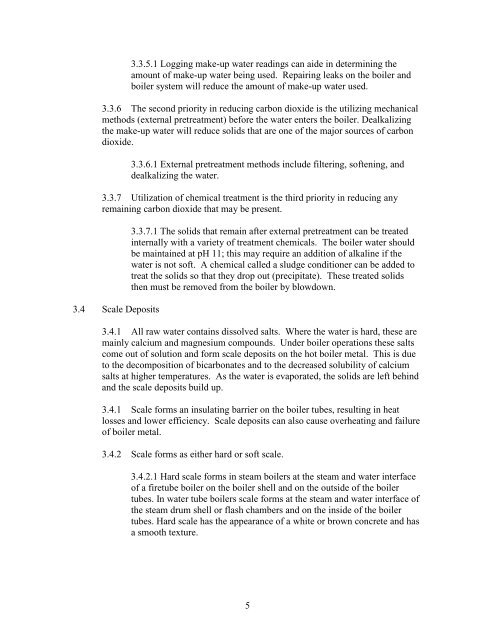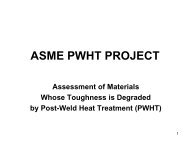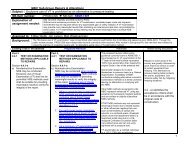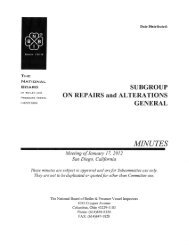DRAFT BOILER/FEEDWATER GUIDELINES - The National Board of ...
DRAFT BOILER/FEEDWATER GUIDELINES - The National Board of ...
DRAFT BOILER/FEEDWATER GUIDELINES - The National Board of ...
You also want an ePaper? Increase the reach of your titles
YUMPU automatically turns print PDFs into web optimized ePapers that Google loves.
3.3.5.1 Logging make-up water readings can aide in determining the<br />
amount <strong>of</strong> make-up water being used. Repairing leaks on the boiler and<br />
boiler system will reduce the amount <strong>of</strong> make-up water used.<br />
3.3.6 <strong>The</strong> second priority in reducing carbon dioxide is the utilizing mechanical<br />
methods (external pretreatment) before the water enters the boiler. Dealkalizing<br />
the make-up water will reduce solids that are one <strong>of</strong> the major sources <strong>of</strong> carbon<br />
dioxide.<br />
3.3.6.1 External pretreatment methods include filtering, s<strong>of</strong>tening, and<br />
dealkalizing the water.<br />
3.3.7 Utilization <strong>of</strong> chemical treatment is the third priority in reducing any<br />
remaining carbon dioxide that may be present.<br />
3.4 Scale Deposits<br />
3.3.7.1 <strong>The</strong> solids that remain after external pretreatment can be treated<br />
internally with a variety <strong>of</strong> treatment chemicals. <strong>The</strong> boiler water should<br />
be maintained at pH 11; this may require an addition <strong>of</strong> alkaline if the<br />
water is not s<strong>of</strong>t. A chemical called a sludge conditioner can be added to<br />
treat the solids so that they drop out (precipitate). <strong>The</strong>se treated solids<br />
then must be removed from the boiler by blowdown.<br />
3.4.1 All raw water contains dissolved salts. Where the water is hard, these are<br />
mainly calcium and magnesium compounds. Under boiler operations these salts<br />
come out <strong>of</strong> solution and form scale deposits on the hot boiler metal. This is due<br />
to the decomposition <strong>of</strong> bicarbonates and to the decreased solubility <strong>of</strong> calcium<br />
salts at higher temperatures. As the water is evaporated, the solids are left behind<br />
and the scale deposits build up.<br />
3.4.1 Scale forms an insulating barrier on the boiler tubes, resulting in heat<br />
losses and lower efficiency. Scale deposits can also cause overheating and failure<br />
<strong>of</strong> boiler metal.<br />
3.4.2 Scale forms as either hard or s<strong>of</strong>t scale.<br />
3.4.2.1 Hard scale forms in steam boilers at the steam and water interface<br />
<strong>of</strong> a firetube boiler on the boiler shell and on the outside <strong>of</strong> the boiler<br />
tubes. In water tube boilers scale forms at the steam and water interface <strong>of</strong><br />
the steam drum shell or flash chambers and on the inside <strong>of</strong> the boiler<br />
tubes. Hard scale has the appearance <strong>of</strong> a white or brown concrete and has<br />
a smooth texture.<br />
5








